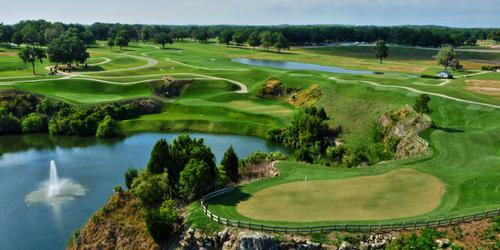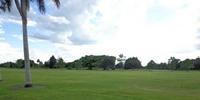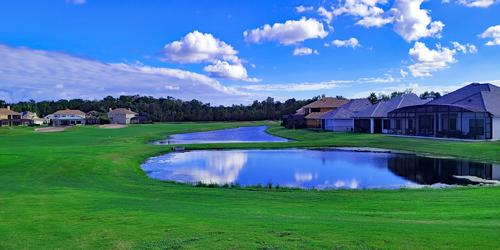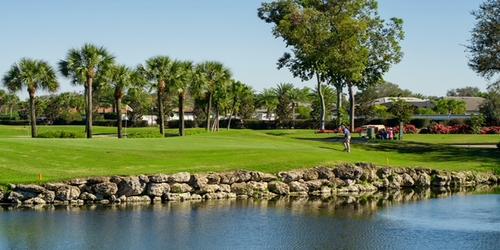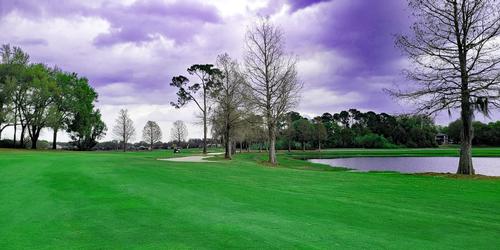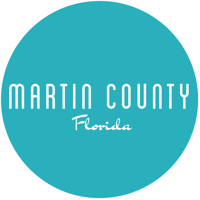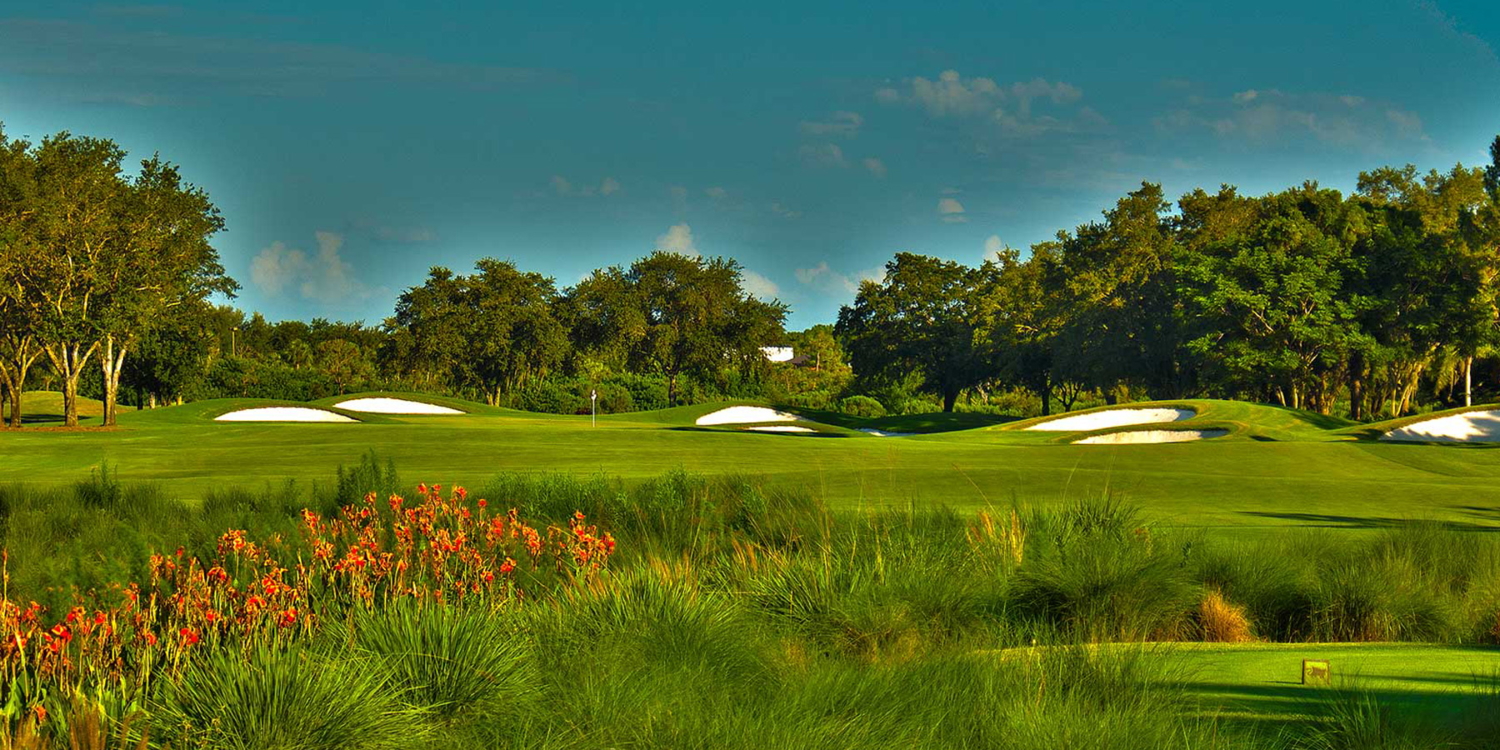
A Dream Golf Getaway
19 Greatest Golf Holes in SW Florida
By Mike May
If you're looking for a golfing holiday, focus your travel plans on 'paradise' - southwest Florida (Lee, Charlotte, Collier, and Hendry Counties). In this part of the world, the weather is exquisite. The average daily temperature is the summer is in the low to mid 80s. In the winter, the mercury hovers around 70 degrees. And, golf courses are in plentiful supply - more than 130 in that four-county area.
Just reading the names of the courses here will help get any golfer's adrenaline flowing. Arrowhead, Embassy Woods, Palm River, Quail Run, Pelican's Nest, Eagle River, Coral Oaks, Riverwood, and Sabal Springs are just a few of the many exciting layouts that await your visit.
To give you a better idea of how wonderful the golf is in 'paradise,' I've decided to give you a closer look. Believe it or not, but 19 of the most scenic, challenging, and memorable holes that you will ever play are located on Florida's Lee Island Coast. What you are about to read is truly the next best thing to being there!
The Front Nine
Hole #1:
Let's begin in Ft. Myers with the 10th hole at the Gateway Golf & Country Club. It's a par four that measures 394 yards from the back tees. What this hole lacks in distance, it makes up for in design. From the tee, you must avoid the six 'Cape Cod' mounds along the left side of the fairway. If you hit your tee shot into the left rough, chances are strong that your ball will stop on the side of a mound or it will nestle in the thick grass that surrounds those mounds. A water hazard, along the right, comes into play as you approach the green. Your approach to the flagstick is influenced by two major factors: a tree in front of the green to the golfer's right and a pair of sand traps left of the green. On this hole, straight is great!
Holes #2 and #3:
A trip down to Naples to play Pelican Marsh, the host of a Senior PGA Tour event (now Champions Tour) in 2000 and 2001, is a great idea. The 4th and 16th holes are two of the more challenging ones in the region. The 4th hole is a par three, 178 yards in length. From an elevated tee, the target is a long, thin green guarded by five -- yes five -- sand traps. Since the tee shot must be hit over water, make sure you take enough club and factor in any wind coming at you from the northwest!
When you first look at the 16th hole, it may remind you of a desert since the sand is a dominant feature between the tee and the green. There are two pot bunkers on the right side of the fairway which you must successfully negotiate from the tee. The perfect tee shot to the fairway should finish either left of center. In other words hit a power fade or a slight draw on your tee shot. As you get ready to hit your second shot on this medium length par five, be aware of the long continuous sand bunker that hugs the right side of the fairway through the green. Your approach shot is to a very receptive green where all the trouble is to the right of the green where sand sits lurking.
Hole #4:
Another 'hall of fame' layout can be found in Bonita Springs - "The Monster" at Pelican's Nest. This is the 5th hole at Pelican's Nest - a 574-yard, par five. This hole is one of the most scenic and challenging holes in southwest Florida. On windy days, even the finest players need a driver, a three wood, and a mid-iron to reach the putting surface. Needless to say, par is a great score and there's nothing wrong with a bogey, either. Birdies at the 5th hole are scarce and eagles are even rarer. From the tee, the golfer must avoid the two fairway bunkers and the out-of-bounds stakes on the right. The second shot is fairly simple, though water lurks on the golfer's left. The third shot to the two-tiered green must avoid the three greenside sand traps.
Hole #5:
One of Naples' more scenic developments is Collier's Reserve. The 18th, which has the Cochahatchee River flowing up the right side of fairway, is one of the finest finishing holes in the area - a 526-yard, par five. If you were to look at this hole from the sky, it's an S-shaped hold - almost like a double dogleg. If you were to look at this hole from the sky, it's an S-shaped hole - almost like a double dogleg. Ideally, you want to hit your tee shot just right of center because there's a sand trap at the left-hand corner of the first dogleg - only 230 yards from the back tees. To get 'home' in two, you must hit a blind shot - a high draw over the trees or a long cut around the corner. Most players, though, will lay up on their second shot - avoiding the two fairway bunkers located about 130 yards from the green. The putting surface is not an easy target. It's a narrow and shallow green protected by a front bunker and the river running along the back. Par here is a treasured score.
Hole #6:
The 15th at Cross Creek in Ft. Myers is a par three that you'll never forget. It's 194 yards from the back tees.....over water. The water hazard also lingers along the left side of the green and behind it. If your tee shot doesn't reach this raised green, hopefully your ball will finish in the bunker to the right of the green or along a small strip of turf that sits between that bunker and the water. Alligators do live in this water, but they won't interfere with your golf game unless you provoke them!
Hole #7:
The 17th hole at Kelly Greens in Ft. Myers is a well-designed piece of property. It's one of the toughest par three holes in the area - 230 yards from the championship tees. Nobody has ever recorded an ace from those back tees. Needless to say, a par is a great score and there's nothing wrong with a bogey, either. From the tee, there's usually a fresh wind in the golfer's face, which means a long iron or a wood is required to reach the putting surface. Other factors to consider: out of bounds along the left, marshlands bordering the fairway on the right, and a group of trees left of the green.
Hole #8:
The 13th hole at the Rookery at Marco in Naples is a visual masterpiece. This 429-yard hole is a slight right-to-left dogleg par four. The scenic features of this hole are its tree-lined fairway to the right.......and water along the left. The slightly elevated green is protected by one large bunker on the front left of this large, undulating green.
Hole #9:
Without a doubt, the best 9th hole in the area is located at Bear's Paw in Naples. It's a classic, straightaway 441-yard par four - the third most difficult hold on the card at Bear's Paw. As you play this hole, beware of the water along the left and the group of trees along the right. The only difficulty you might encounter while trying to reach the putting surface is a solitary sand trap, situated greenside left.
The Back Nine
Holes #10 and #11:
There's nothing like the beginning the last nine holes with a par five. The third hole at Lexington in Ft. Myers rivals "The Monster" at Pelican's Nest - a long par five, more than 600 yards long. Even a big hitter like Bubba Watson or John Daly would probably need three shots to reach the green on this hole. A birdie here is a very rewarding score and a par doesn't come easy. From the back tees, your tee shot must travel at least 230 yards over water. Position is everything on your second shot as you must avoid a lake that's approximately 130 yards short of the green. Once you've conquered the water hazards, your next challenge is to stay clear of the three greenside bunkers.
Lexington's fifth hole is an excellent test for any golfer - a 479-yard par four. Because of the length of this hole, a bogey is not an uncommon score. The best landing area for your tee shot is the left-hand portion of the fairway because that's the shortest route over the lake. Because of this hole's length, the fairway is wide and forgiving. It's important to know your yardage to the pin on your second shot because the green is very deep - nearly a two-stroke club difference between the front and back of the green. Inaccurate approach shots to the green are penalized by water to the right and out-of-bounds stakes to the rear.
Holes #12 & #13 & #14:
The next three holes can be found at the Riverwood Golf Club in Port Charlotte, which GolfWeek ranked in 2012 as the 15th best course you can play in Florida. I am referring to holes #6, #9, and #18.
The 6th is a par four and is 424 yards long - from the championship tees. A wayward tee shot may end up 'wet' if it goes too far left. The green is wide and shallow. The putting surface is protected by a greenside sand trap (front left), and a water hazard (behind the green). The location of the pin dictates what side of the fairway that you aim for off the tee so you can best negotiate the lone pine tree.
Riverwood's 9th hole is a very narrow, straight away par five - 539 yards long. This hole favors an accurate big hitter. Woods threaten on both sides of the fairway and a pair of fairway bunkers will swallow up any errant tee shots. As you get closer to the hole, it's important to keep the ball right of center as a water hazard and a sand trap lurk on the left side of the green.
The 18th hole at Riverwood is one that would get the attention of PGA Tour professionals because it's a par four, measuring 455 yards from the tips. To add to its degree of difficulty, the hole dog legs to the right and features a strategically placed fairway bunker and long green-side sand trap to the right of the green. The 18th is a challenging finishing hole that typically plays into the wind.
It's worth noting that the 9th and 18th at Riverwood are two of the toughest finishing holes in the area.
Holes #15 & #16:
The 9th at the Arrowhead Golf Club is a true test of patience and grit, especially if the wind is blowing in your face. This 445 yard par four - from the championship tees -- is a right-to-left dogleg around a big lake. Any tee shot to the left is wet, but the more that you can hug the left side of the fairway, the shorter it will make your approach to the green. A conservative tee shot is down the right side of the fairway. A strategic tee shot is along the left edge of the fairway. From the fairway, you will be left with a mid to long iron to a raised putting surface. Since there are no hazards in front of the green, it's possible to save par with an accurate chip-and-run approach with your third shot, assuming that you don't reach the green in regulation. The hole plays longer than the official yardage because of the lingering presence of the lake from tee to green. There's nothing wrong with a bogey five at the 9th, especially when the wind is in your face! As they say, when's it's breezy, swing easy!!
The 1st hole at Arrowhead is a par five - measuring 596 yards from the championship tees and 561 yards from the tournament and back tees. It's important to be warmed up, having hit some range balls before you step on the first tee here at Arrowhead. While the first fairway is spacious, errant tee shots to the right can drift out of bounds and bad tee shots to the left might find a 'watery grave' as a massive lake borders the first hole for most of its existence. As you get closer to the putting surface, the fairway shrinks in size as the OB to the right, a pond to the left, and the lone greenside sand trap to the left of the green begin to get more visible. Play conservatively at this hole and keep the ball in play. Straight hitters will be rewarded with a good score.
Hole #17:
Ft. Myers is home of the 'Long and Mean' course at the Fiddlesticks Country Club. The 17th hole on this private layout is a fair test for any player as this par three measures 193 yards from the back tees to the middle of the green. If your tee shot doesn't reach the green, it will land in either the water or a sandy 'waste' area that is perched at the base of this raised green. Because of the size of the putting surface - 15 yards wide by 35 yards deep - there are a number of pin-placement possibilities which can dramatically influence your club selection. In the winter, there's usually a strong wind in the player's face.
Hole #18:
The 'home' hole is the 18th on the 'Bay Island' course at Bonita Bay. It's a picturesque challenge - a 434-yard par four. The target for the tee shot is a narrow landing area. From 225 yards off the back tees (but, of course, less for those hitting from the more forward tee boxes), a huge sand bunker comes into play on the right. This massive bunker continues for another 100 yards down the fairway. If you guard too much from hitting into the bunker, you could encounter the lateral hazard along the left. Once off the tee, you're looking at a boomerang-shaped green that bends to the left. Sand bunkerss have been placed on both sides of the putting surface. To add to the degree of difficulty, the wind is almost always in the golfer's face.
The 19th Hole (and it's not a bar!):
The Panther Run Golf Club, located in Ave Maria, Florida, is located due east of Naples. This course is also the 'home' of two nearby collegiate golf teams, the men's and women's golf teams at Ave Maria University (the 'Gyrenes'). The 1st hole - named Cordgrass Corridor - is a terrific par four which measures 461 yards from the back tees. While a beautiful lake sits lurking to the left of the first fairway, it really doesn't come into play off the tee. While the first fairway is specious, you are rarely left with a flat lie as the 'short grass' is filled with undulations. On your approach to the green, beware of another body of water to the right of the green and a sand trap, which is located on the front right of the putting surface. The elongated green gives the club many options on pin placements, which adds to the appeal of the opening hole!
Revised: 02/01/2016 - Article Viewed 27,473 Times
About: Mike May
![]() Mike May is a Wellington, Florida-based freelance golf and sportswriter, who is also a 25+ year public relations and communications executive in the sporting goods industry. He is also a veteran high school soccer official, an experienced high school basketball coach, an avid athlete, a part-time personal trainer, and a passionate golfer who is forever in pursuit of Old Man Par. He is a member of the Golf Writers Association of America.
Mike May is a Wellington, Florida-based freelance golf and sportswriter, who is also a 25+ year public relations and communications executive in the sporting goods industry. He is also a veteran high school soccer official, an experienced high school basketball coach, an avid athlete, a part-time personal trainer, and a passionate golfer who is forever in pursuit of Old Man Par. He is a member of the Golf Writers Association of America.
Contact Mike May:
GolfTrips.com - Contributor





